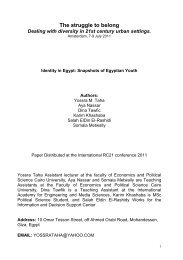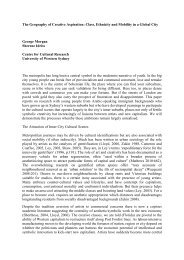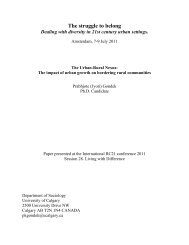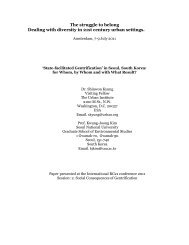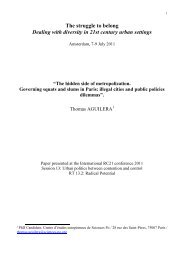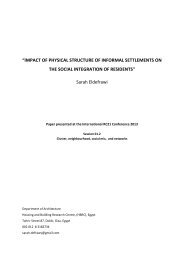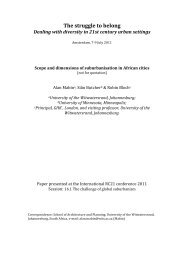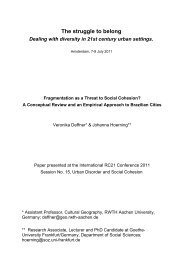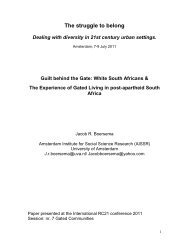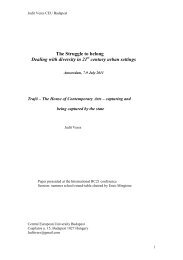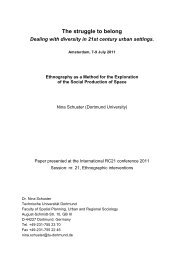Gentrification in the mill land areas of Mumbai city - RC21 ORG ...
Gentrification in the mill land areas of Mumbai city - RC21 ORG ...
Gentrification in the mill land areas of Mumbai city - RC21 ORG ...
You also want an ePaper? Increase the reach of your titles
YUMPU automatically turns print PDFs into web optimized ePapers that Google loves.
Conceptualis<strong>in</strong>g gentrification <strong>in</strong> <strong>the</strong> context <strong>of</strong> <strong>Mumbai</strong><br />
<strong>Gentrification</strong> is a burgeon<strong>in</strong>g phenomenon <strong>in</strong> today’s world, where <strong>the</strong> mean<strong>in</strong>g itself got<br />
gentrified time and aga<strong>in</strong> with certa<strong>in</strong> positive and negative connotation attached to it. In<br />
1980 Oxford American Dictionary states gentrification “as <strong>the</strong> movement <strong>of</strong> middle class<br />
families <strong>in</strong>to urban <strong>areas</strong> caus<strong>in</strong>g property values to rise and hav<strong>in</strong>g <strong>the</strong> secondary effect <strong>of</strong><br />
driv<strong>in</strong>g out poorer families (Schaffer &Smith, 1986:347).” From <strong>the</strong>n onwards different<br />
debates started regard<strong>in</strong>g <strong>the</strong> causes and consequences <strong>of</strong> gentrification, how it had taken<br />
place <strong>in</strong> different cities around <strong>the</strong> world. The term can be expla<strong>in</strong>ed <strong>in</strong> various ways.<br />
Available literature expla<strong>in</strong>s gentrification <strong>in</strong> three different ways. The first was mentioned<br />
by (Ley, 1981, 1996) and o<strong>the</strong>rs who argue that gentrification happens due to <strong>the</strong> shift <strong>in</strong> <strong>the</strong><br />
<strong>in</strong>dustrial structure <strong>in</strong> <strong>the</strong> cities from manufactur<strong>in</strong>g to service based <strong>in</strong>dustries, <strong>the</strong>re by<br />
chang<strong>in</strong>g <strong>the</strong> occupational class structure. Secondly as a result <strong>of</strong> changes <strong>in</strong> class<br />
composition and occupational structure <strong>the</strong>re is also cultural transformation. The middle class<br />
colonises <strong>in</strong> <strong>the</strong> core area <strong>in</strong>stead <strong>of</strong> <strong>the</strong> suburban area. Therefore it is <strong>the</strong> newly formed<br />
middle class which makes gentrification. Thirdly, Smith (1979, 1987, 1996) as cited by<br />
Hamnett (2003) argued that <strong>the</strong> ma<strong>in</strong> force beh<strong>in</strong>d gentrification is not <strong>the</strong> new middle class<br />
but <strong>the</strong> rent gaps. There are three <strong>in</strong>ter related processes that leads to gentrification. First, due<br />
to certa<strong>in</strong> global forces it has been observed as “cascad<strong>in</strong>g <strong>in</strong>to new territories”, secondly, it<br />
is a product <strong>of</strong> cosmopolitan lifestyles practised by certa<strong>in</strong> fractions <strong>of</strong> “transnational<br />
capitalist classes” (R<strong>of</strong>e, 2003: 2518) as cited by Harris (2008) and lastly, it is an important<br />
part <strong>of</strong> neoliberalism. (Harris, 2008: 2409). The process <strong>of</strong> gentrification whe<strong>the</strong>r <strong>in</strong> Europe,<br />
<strong>in</strong> USA or <strong>in</strong> Australia was sporadic <strong>in</strong> nature till <strong>the</strong> neo liberalisation period appeared. Later<br />
with <strong>the</strong> passage <strong>of</strong> time, it had acquired a wider extent. Therefore, <strong>the</strong> ma<strong>in</strong> characteristics <strong>of</strong><br />
gentrification exhibited that it is not only evenly distributed across towns and cities but it is<br />
also concentrated <strong>in</strong> small regions and <strong>areas</strong> <strong>of</strong> large cities such as London, New York, Paris,<br />
Sydney, Toronto, Boston and San Francisco (Hamnett, 2003).<br />
The processes <strong>of</strong> gentrification have both positive and negative impacts. It tends towards<br />
stabilisation <strong>of</strong> <strong>the</strong> decl<strong>in</strong><strong>in</strong>g <strong>areas</strong> by improv<strong>in</strong>g <strong>the</strong> hous<strong>in</strong>g, decentralis<strong>in</strong>g <strong>the</strong> poverty from<br />
<strong>the</strong> area <strong>in</strong>creas<strong>in</strong>g <strong>the</strong> property value and local revenues with fur<strong>the</strong>r development and<br />
ultimately reduc<strong>in</strong>g <strong>the</strong> urban sprawl. It also <strong>in</strong>troduces socio cultural changes <strong>in</strong> <strong>the</strong> area by<br />
<strong>in</strong>creas<strong>in</strong>g social mix<strong>in</strong>g <strong>of</strong> people. At <strong>the</strong> same time <strong>the</strong> process <strong>of</strong> gentrification causes<br />
large scale displacement <strong>of</strong> population <strong>the</strong>reby creat<strong>in</strong>g homelessness. This displacement <strong>of</strong><br />
population is due to <strong>in</strong>crease <strong>of</strong> price and high demand for hous<strong>in</strong>g. Therefore, this process




